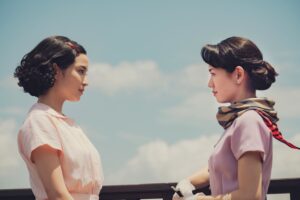TIFF Review: “A Pale View of Hills”
Written by: Christopher Llewellyn Reed | September 15th, 2025

A Pale View of Hills (Kei Ishikawa, 2025) 3 out of 5 stars
Born in 1954 in Nagasaki, Japan, Nobel-prize-winning author Kazuo Ishiguro emigrated to England in 1960. His subsequent bicultural upbringing has given him a unique perspective on the world that has informed much of his writing, specializing in the emotional reserve that humans layer on top of experience to avoid looking closely at hard truths. His novels The Remains of the Day (1989) and Never Let Me Go (2005)—both of which were adapted for the cinema (in 1993 and 2010, respectively)—are among my favorite works of literature of all time.
Ishiguro’s 1982 debut, A Pale View of Hills (intriguing, but not as resonant to me as the aforementioned books), has just received its own eponymous adaptation, from Japanese director Kei Ishikawa (A Man). It is set in two different places and time periods: Nagasaki in the early 1950s, the year during which its recent nuclear bombing by the United States was still a fresh memory; and 1982 England, where the young woman, Etsuko, who is the main character of the first section, is now a fifty-something widow and mother. Suzu Hirose (At the Bench) plays Etsuko in the Japanese part of the story. Her radiant turn makes the rest of the movie shine.

Like the source text, the movie A Pale View of Hills plays with the essence of reality, though this shifting narrative sand is not evident until the end. Ishiguro loves to make his readers question his protagonists’ perspective, and director Ishikawa respects this foundational construct. For much of the runtime, however, we simply cut between the past and “present” (within the film) of the story, the former ostensibly informing the latter.
In the 1950s, Etsuko is married to Jiro (Kôhei Matsushita, I Am Makimoto) and expecting her first child. When her father-in-law (Tomokazu Miura, The Lines That Define Me) comes for a visit, she alternates between spending time with him and hanging out with new friend Sachiko (Fumi Nikaidô, Tsuki), a single mother who lives nearby. Times are hard, but she and Jiro do alright, even if he is either working or getting drunk with colleagues after work.

In the 1980s, the older Etsuko (Yoh Yoshida, My Broken Mariko) hosts her half-English daughter, Niki (Camilla Aiko, Lee), in the house she plans to sell now that her husband (not Jiro, but someone else) is dead. She had another daughter, Keiko, whom Niki mentions frequently but we never see. We’ll learn about her fate as the film progresses. Niki, a journalist, decides to write about post-nuclear-bomb Nagasaki, which proves the motivating factor for the story’s ping-ponging back and forth.
Slowly, we gather information about Etsuko’s life then and later, though a full portrait remains elusive, by design. Following Ishiguro’s lead, Ishikawa avoids a pat resolution to either decade’s tale, leaving the conclusions for us to imagine. This makes for a sometimes-exasperating watch, but along the way the director includes discussions of societal responsibility for war and its consequences, and the cost of emigration and assimilation. Though committedly elliptical to a fault, A Pale View of Hills nevertheless offers us a chance to bask in Suzu Hirose’s performance. That’s well worth the accompanying frustrations of such an opaque final enigma.


